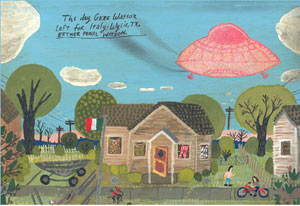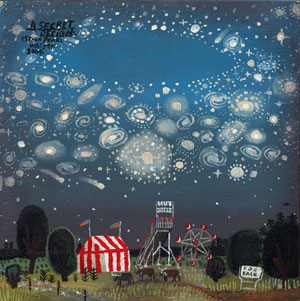As she’s classically trained, her approach to the chronicling of her childhood and adolescence seems intentionally primitive, perhaps to further advance the unrefined characteristics of not only youth in general but of rural living as well. In this light, I thought of the paintings as not really a recollection, but instead as a present tense retelling from the most accurate vantage point of the past tense. If I’m right and I don’t look/read like a jackass in this and the previous sentences – Ms. Watson, my email door is open to knocking – it strikes me as an interesting tactic, and one that would really appeal to any thespian with a real jones for Stanislavski…
The paintings themselves tend to be of rather mundane events in rural settings, with children playing under entangled starlight, even a dilapidated home here or there. It’s just that…there’s usually a gigantic spaceship in a portion of the frame as well. And while they’re stylistically dissimilar, Watson’s work immediately brought to mind a couple films and a Midwestern painter from long ago.
First, the cinematic consideration…for some reason, Tim Burton’s early work of genius (that featured Johnny Depp’s proclivity for funhouse weird), “Edward Scissorhands” , came to mind. The cartoonish approach of Burton aesthetically and otherwise created an optical illusion that addressed the isolation and cruelty of suburbia that has a parallel in Watson’s work….where all of the perspective seems to be levitating above the action, trying to understand the secrets of what’s happening underneath and within. And even stranger, the other film that came to the fore was Richard Brooks’ work of genius in 1967, “In Cold Blood” , working celluloid wonder to project abject terror through deft camerawork and the power of suggestion to the dark recesses of the human mind. There’s an eerie, creaky element to Watson’s work that treads this very fine line between a cozy nostalgia and the emotional detachment almost necessary to process such a surreal landscape of a childhood such as this. It’s almost as if I doubt that the paintings are telling me the entirety of the truth, and I’m drawn to the idea that ‘finished’ art can very well live in the world of unfinished stories and sentences, incomplete ideas and such. Behind the house, behind the curtains, behind the door of the half-finished spaceship, there are far more stories to be told. And perhaps my imagination is something that Ms. Watson wants me to take hold of to tell the rest of her story, or to create my own…
This fine art blogging is dense business. I can dig it, for I am up to the task…





